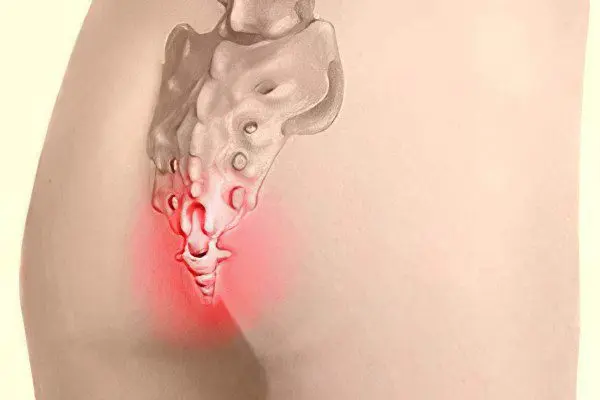Contents

First, let’s delve a little into human anatomy. What is a coccyx? This is a small bone, in an adult it consists of 4-5 fused vertebrae. It is connected to the sacrum by a kind of joint, reinforced with ligaments. The connection of the coccyx and sacrum has low mobility, but in women it is more pronounced. During childbirth, the coccyx deviates back, increasing the birth canal.
At a young age, the vertebrae of the coccyx are interconnected by layers of cartilage.
The coccyx is well protected from external influences by an array of gluteal muscles and is surrounded by a large number of highly sensitive nerve fibers.
Muscles and ligaments involved in the activity of the genitourinary organs are attached to the coccyx. In its front part there is a nerve plexus, from which the nerve channels and endings in the anus and pelvic organs branch.
The coccyx is an important fulcrum that is involved in the distribution of physical load on the small pelvis. For example, when a person in a sitting position leans forward, the load moves to the lower part of the ischial bones, when he leans back, the coccyx takes on a partial role as a fulcrum.
A tailbone fracture can be the result of:
falling on the buttocks (a traumatic force is directed to the upper part of the coccyx);
a direct blow with a blunt and narrow object (the outer surface is damaged);
childbirth (the inner surface of the coccyx is injured), when a large fetus passes through the birth canal, tears and significant displacements of the coccyx-sacral joint are possible;
traffic accidents;
long driving and shaking in the vehicle.
Symptoms of a tailbone fracture
Experienced traumatologists say that in most cases of coccyx injury, we are not talking about a true fracture, but about damage to the ligaments of the joint connecting the coccyx to the sacrum, displacement of the coccygeal vertebrae relative to each other, and ruptures of the connections between them.
It is possible to talk about a fracture only when fractures of small bone processes of the coccyx become a consequence of an injury. A true closed fracture, caused by congenital degeneration or acquired with age, occurs in practice in isolated cases.
It is generally accepted that fractures of the coccyx most often occur in the elderly and children. However, traumatologists report that the vast majority of cases of fracture-dislocation of the coccyx occur among young women. In children, only dislocations are observed.
In coccyx fractures, radiographic findings and clinical evaluation are equally important.
The main symptoms of a fracture are:
piercing pain in the area of injury;
difficulty in moving;
the inability to be in a sitting position and a sharp increase in pain when trying to get up;
difficulty defecation due to severe pain.
How to determine a fracture of the coccyx?
It is impossible to independently determine the features of damage to the coccyx. The final diagnosis can only be made by a doctor after carrying out diagnostic measures:
Direct examination of the patient. Swelling is clearly visible in the area of injury, a hematoma is possible. With a load on the upper part of the coccyx, the patient experiences acute pain.
X-ray of the coccyx. A standard study is performed in direct (in the supine position with straight legs) and lateral (on the side with bent legs) projection. The fracture can not always be seen on the radiograph, since the small bones of the coccyx hide an array of soft tissues.
Computed tomography of the spine. The most informative method that makes available the detailing of dense structures.
Magnetic resonance imaging. In addition to determining the state of bone tissue, this study checks the integrity of nerve fibers and blood vessels, muscles and skin.
Vaginal and rectal examination. Sometimes it allows you to feel crepitus (a characteristic crunch that occurs when bone fragments are rubbed). Without extreme necessity, it is not prescribed, since the information content of the study is low, and the patient experiences discomfort during the procedure.
The consequences of a fracture of the coccyx
A fracture of the coccygeal spine can be without displacement and with displacement of bone fragments.
The last type of fracture is the reason for the development of various pathologies:
Chronic headache (migraine).
Spinal cord injury. A condition in which pain syndrome accompanies the patient constantly (especially felt when doing squats), significantly worsening the quality of life.
Complicated childbirth. In women who have suffered a fracture of the coccyx, there is an increased pain syndrome during childbirth.
Salt deposition or callus formation. This condition is also accompanied by constant pain when sitting and their intensification when standing up.
Anacoccygeal pain (coccygodynia). Pain syndrome, localized in the coccyx. In most cases, it is observed in women. The pain is aggravated while sitting, walking and defecation. Coccygodynia occurs with neuralgia of the nerve fibers surrounding the coccyx and with damage to its periosteum. Usually appears against the background of other neuralgic disorders.
Since the coccyx area itself has hypersensitivity and reacts extremely painfully to the slightest bruises, it is very uncomfortable for a person to live, experiencing constant pain, aggravated by movement.
Displaced coccyx fracture
This type of fracture is the most painful and will certainly cause difficulties in the movement of a person, since the displacement of bone fragments leads to injury to the neurovascular bundle and soft tissues.
Since the bones are displaced, the process of their fusion becomes more complicated and, at the same time, the pain syndrome is far from the most unpleasant consequence. Surgical removal of bone fragments can cause an abscess of the coccyx, accompanied by defecation disorders and the formation of fistulas.
A displaced coccyx fracture is a big problem for women planning a pregnancy. This diagnosis is an indication for a caesarean section, but not all expectant mothers agree to an operation of this kind.
In order to understand whether natural childbirth is available with such an injury, it is necessary, even before the onset of pregnancy, to take an x-ray and present the results to an experienced gynecologist. Having the size of the pelvis and taking into account the reduced mobility of the broken coccyx, the specialist will be able to determine whether natural childbirth is possible or surgical intervention is necessary.
What to do with a fracture of the coccyx?
So, there was an unpleasant fall, you hit your tailbone hard and it hurts, what should you do? Before the arrival of the ambulance and a professional examination of the traumatologist, you need to relieve the pain. First, try to lie down and apply a cold compress to the affected area.
It is usually recommended to lie down so that the injured area does not touch the surface. However, the human body is its own best healer, it will tell you (by increasing or easing pain) what position should be taken.
You can take painkillers. In this case, baralgin or ketanol is suitable, two tablets will be enough, diclofenac can be used.
Tailbone fracture treatment

At the acute and subacute stages, patients are prescribed conservative treatment. The main task of doctors is to urgently stop the pain and relieve swelling.
While the pain syndrome is pronounced, the patient is shown bed rest. In order to ensure peace, a special orthopedic device is used, which we will discuss below.
As needed, the doctor may prescribe a local anesthetic. In some cases, the use of ointments may be indicated, provided that the integrity of the skin is not broken. It is possible to use rectal suppositories based on Voltaren (diclofenac). To prevent constipation and displacement of the coccyx vertebrae, rectification enemas are prescribed.
A special tire is applied to the patient, which is a gauze circle with cotton wool inside.
As a rule, severe pain goes away within a week, after which the patient is allowed to get up.
Surgery
Surgical treatment is indicated if it is necessary to correct the deformity and significant displacement of the fragment. The task of the surgeon is to remove the damaged fragment of the coccyx.
Surgical intervention can also be prescribed for compression of the pelvic organs and, as a result, a violation of their natural functioning, improper passion of the coccyx segments. The operation is quite complicated – manipulations should not lead to damage to the rectum.
To maintain the correction of coccyx deformity after surgical treatment, the doctor prescribes bed rest and rest for up to 10 days and an appropriate diet.
With a pain syndrome that has not stopped for a long time (coccygodynia), it is necessary to remove the coccyx. The consequences of such an operation can be suppuration, fistulas and hematomas.
Proper nutrition
During the treatment of an injury, it is necessary to take care of the correct diet. You need to eat foods high in calcium: dairy products (cottage cheese, milk), cabbage, herbs, fish, persimmon, sesame and hazelnuts.
In order for the calcium entering the body to be absorbed, silicon must be present in the diet. This element is found in currants, olives, radishes and cauliflower.
In the treatment of the consequences of a fracture of the coccyx, it is possible to use narrowly targeted methods:
hydrotherapy;
Paravertebral injection;
Electroanalgesia.
Orthopedic pillow for fracture of the coccyx

Above, we mentioned that in the treatment of a fracture of the spine, the patient is prescribed the observance of the pastel regimen. In order to prevent pressure on the damaged area and prevent the formation of bedsores, an orthopedic pillow is used.
This device has a special shape that provides the greatest comfort in the sitting position. Thanks to the hole in the pillow, the load is removed from the sacrococcygeal region, the patient does not experience pressure on the damaged area, which means that he does not feel pain.
As rehabilitation measures it is recommended:
physiotherapy;
phytotherapy;
acupuncture;
massage.
Given the correct construction of the treatment and rehabilitation course, doctors manage to achieve an improvement in the patient’s condition after 14 days. On average, the process takes four weeks. In some cases, recovery takes several months, it all depends on the characteristics and severity of the injury.
Postponing an appeal to a traumatologist if you suspect a fracture of the coccyx “for later” should not be. The recovery time after an injury and the quality of later life depend on the speed of receiving professional help.










meni dum suyagim ozgincha siljigan va singan 1 yil boldi haligachaa ozmni noqulay his qilaman ogriydi ishlasam nima qilsam boladi
meni dum sayagim ham ozgincha siljib singan , keyin tugishimga oqgriqli asoratlari bolmaydimi